TOYOTA FJ CRUISER 2010 1.G Owners Manual
Manufacturer: TOYOTA, Model Year: 2010, Model line: FJ CRUISER, Model: TOYOTA FJ CRUISER 2010 1.GPages: 439, PDF Size: 11.02 MB
Page 341 of 439
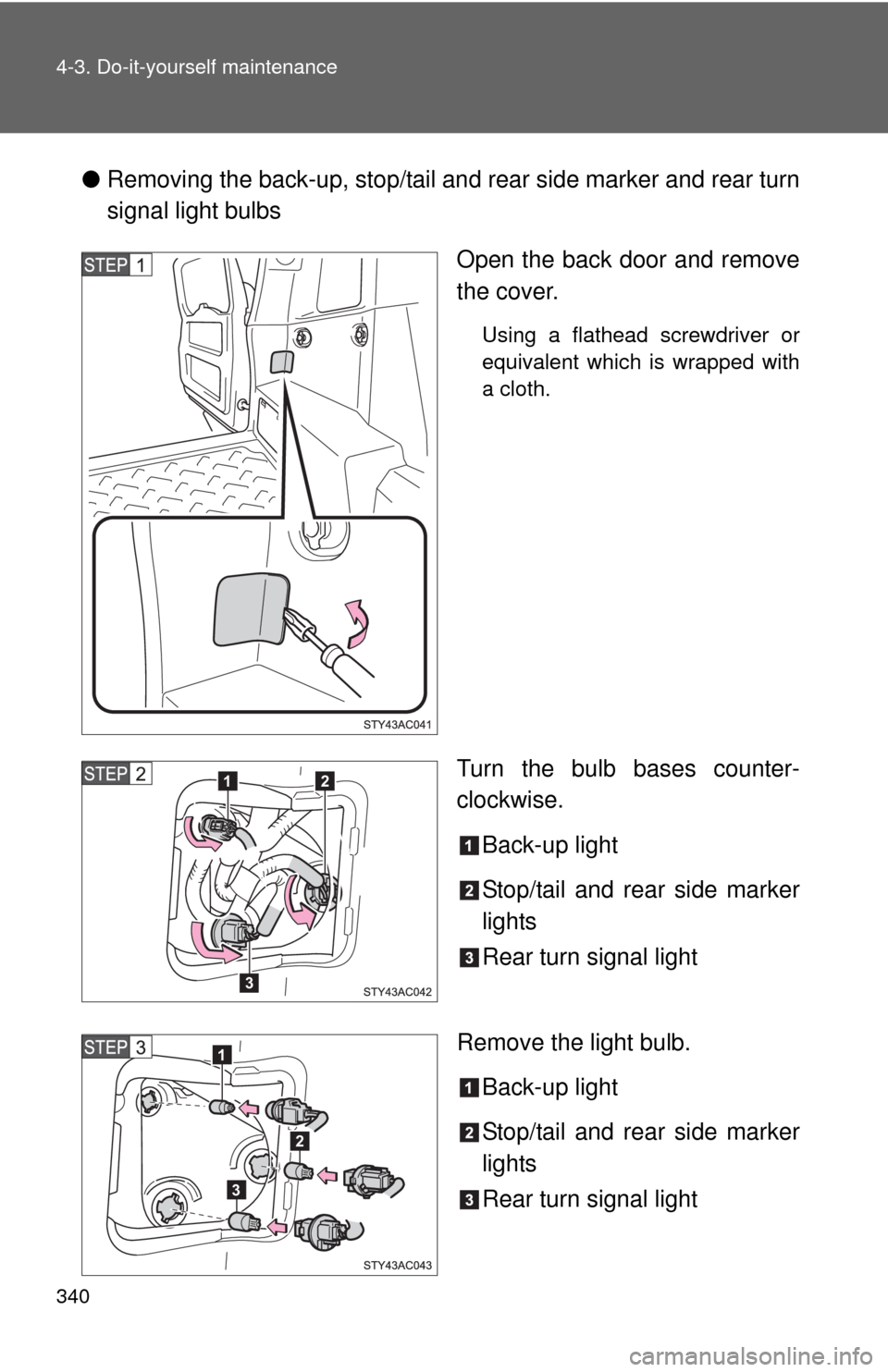
340 4-3. Do-it-yourself maintenance
●Removing the back-up, stop/tail and rear side marker and rear turn
signal light bulbs
Open the back door and remove
the cover.
Using a flathead screwdriver or
equivalent which is wrapped with
a cloth.
Turn the bulb bases counter-
clockwise.
Back-up light
Stop/tail and rear side marker
lights
Rear turn signal light
Remove the light bulb.
Back-up light
Stop/tail and rear side marker
lights
Rear turn signal light12
3
1
3
2
Page 342 of 439
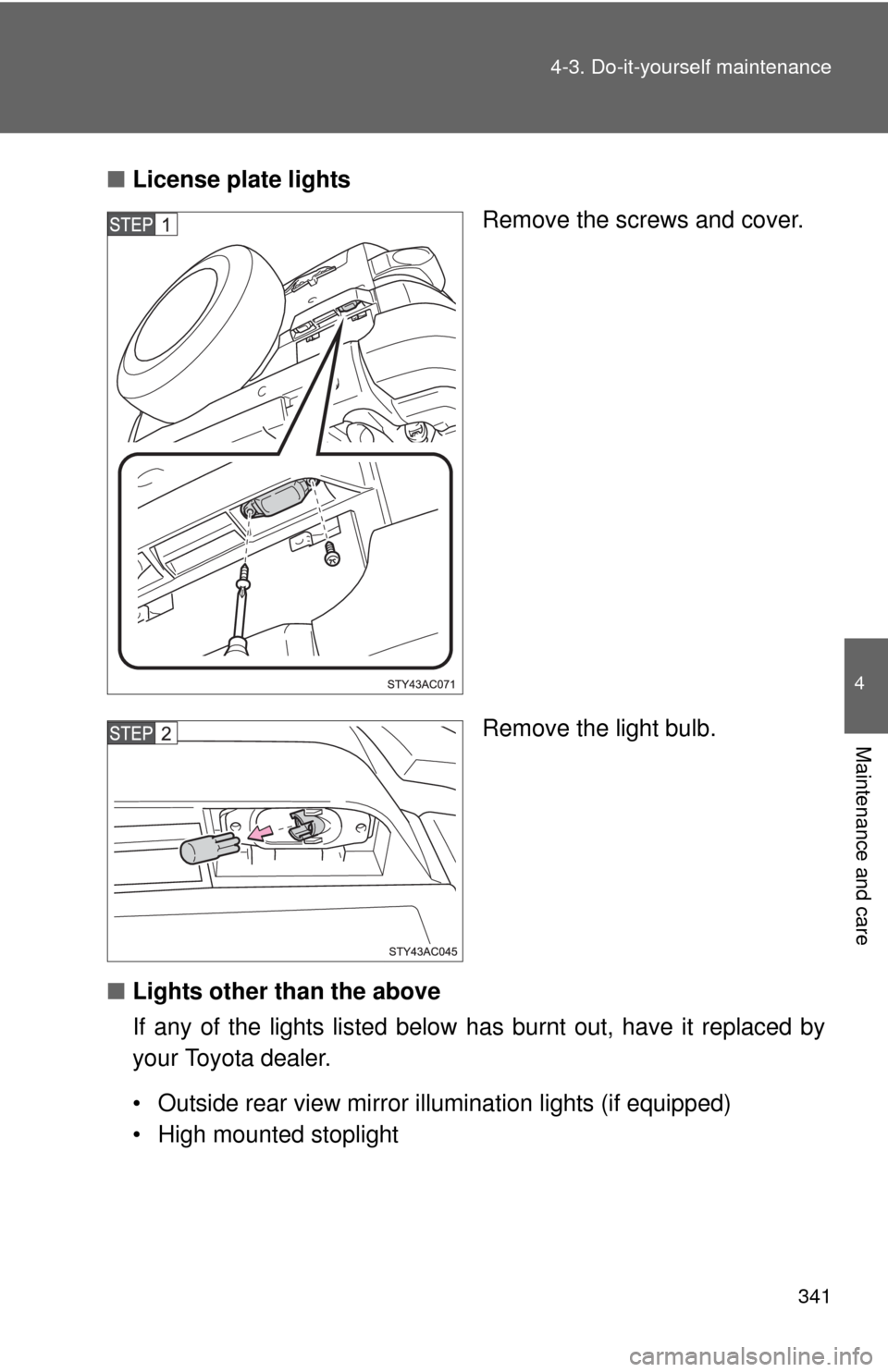
341 4-3. Do-it-yourself maintenance
4
Maintenance and care
■License plate lights
Remove the screws and cover.
Remove the light bulb.
■Lights other than the above
If any of the lights listed below has burnt out, have it replaced by
your Toyota dealer.
• Outside rear view mirror illumination lights (if equipped)
• High mounted stoplight
Page 343 of 439
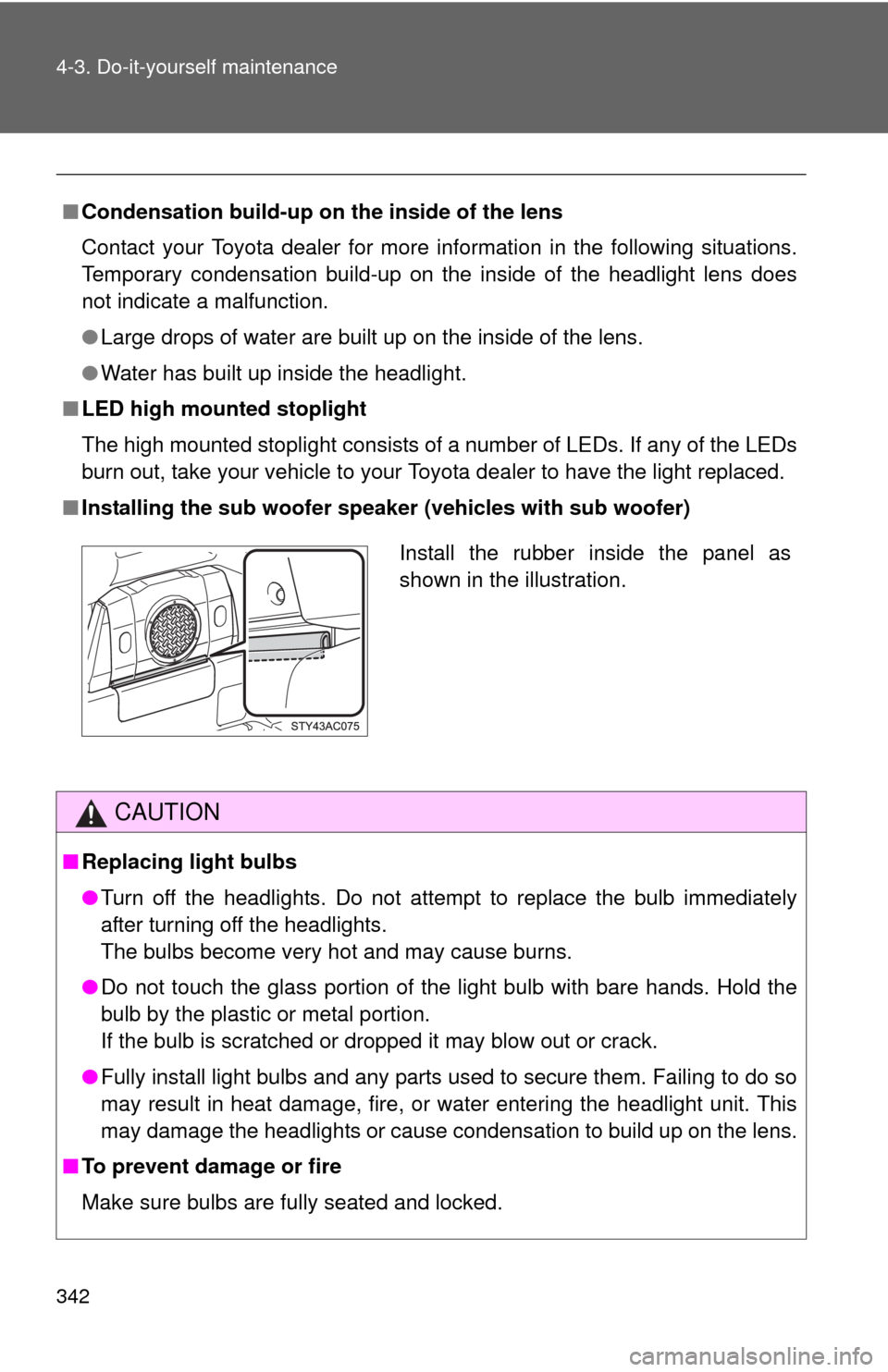
342 4-3. Do-it-yourself maintenance
■Condensation build-up on the inside of the lens
Contact your Toyota dealer for more information in the following situations.
Temporary condensation build-up on the inside of the headlight lens does
not indicate a malfunction.
●Large drops of water are built up on the inside of the lens.
●Water has built up inside the headlight.
■LED high mounted stoplight
The high mounted stoplight consists of a number of LEDs. If any of the LEDs
burn out, take your vehicle to your Toyota dealer to have the light replaced.
■Installing the sub woofer speaker (vehicles with sub woofer)
CAUTION
■Replacing light bulbs
●Turn off the headlights. Do not attempt to replace the bulb immediately
after turning off the headlights.
The bulbs become very hot and may cause burns.
●Do not touch the glass portion of the light bulb with bare hands. Hold the
bulb by the plastic or metal portion.
If the bulb is scratched or dropped it may blow out or crack.
●Fully install light bulbs and any parts used to secure them. Failing to do so
may result in heat damage, fire, or water entering the headlight unit. This
may damage the headlights or cause condensation to build up on the lens.
■To prevent damage or fire
Make sure bulbs are fully seated and locked.
Install the rubber inside the panel as
shown in the illustration.
Page 344 of 439
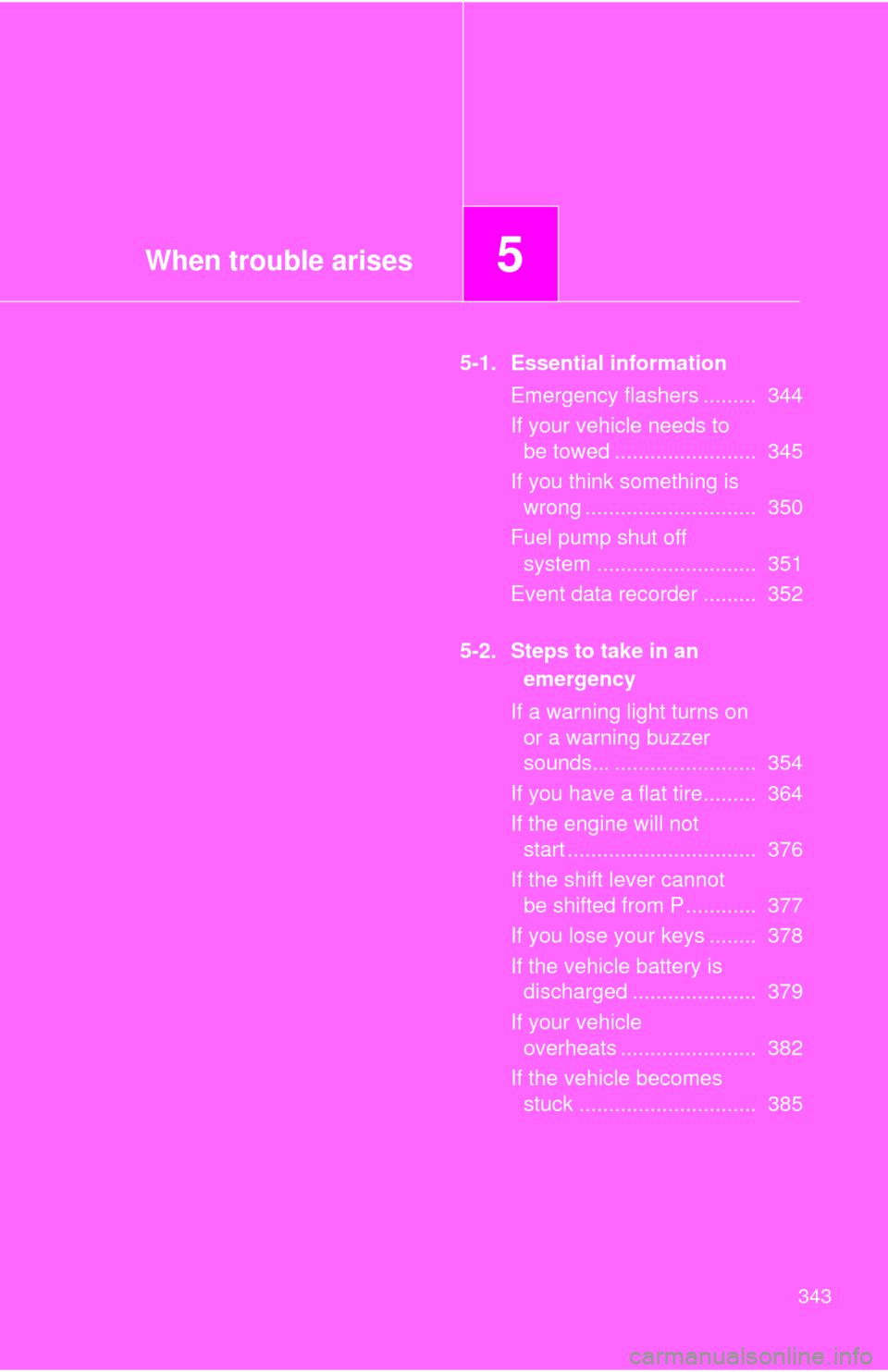
When trouble arises5
343
5-1. Essential information
Emergency flashers ......... 344
If your vehicle needs to
be towed ........................ 345
If you think something is
wrong ............................. 350
Fuel pump shut off
system ........................... 351
Event data recorder ......... 352
5-2. Steps to take in an
emergency
If a warning light turns on
or a warning buzzer
sounds... ........................ 354
If you have a flat tire......... 364
If the engine will not
start ................................ 376
If the shift lever cannot
be shifted from P............ 377
If you lose your keys ........ 378
If the vehicle battery is
discharged ..................... 379
If your vehicle
overheats ....................... 382
If the vehicle becomes
stuck .............................. 385
Page 345 of 439

344
5-1. Essential information
Emergency flashers
NOTICE
■To prevent battery discharge
Do not leave the emergency flashers on longer than necessary when the
engine is not running.
Use the emergency flashers if the vehicle malfunctions or is
involved in an accident.
Press the switch to flash all
the turn signal lights. To turn
them off, press the switch
once again.
Page 346 of 439
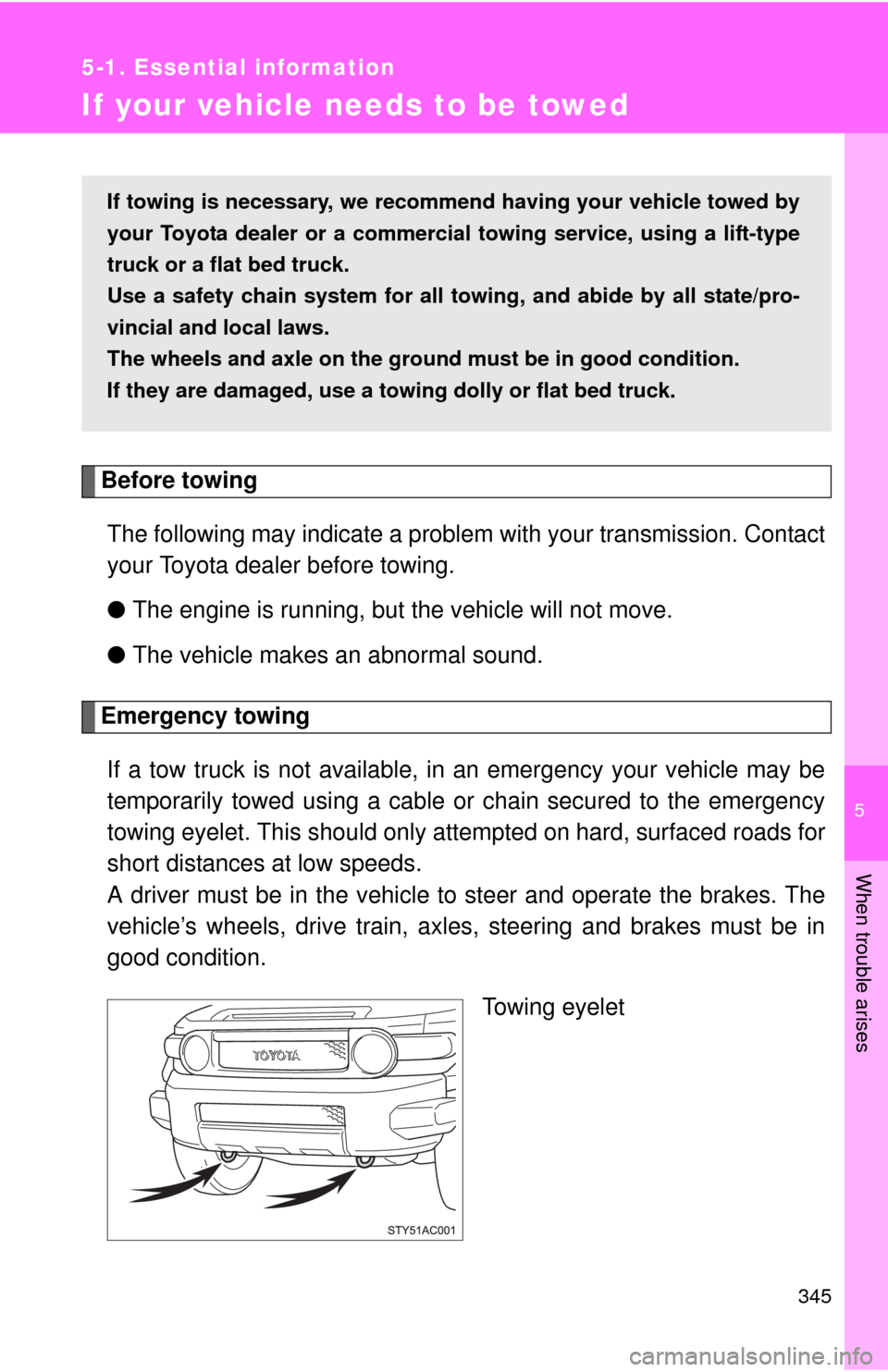
5
When trouble arises
345
5-1. Essential information
If your vehicle needs to be towed
Before towing
The following may indicate a problem with your transmission. Contact
your Toyota dealer before towing.
●The engine is running, but the vehicle will not move.
●The vehicle makes an abnormal sound.
Emergency towing
If a tow truck is not available, in an emergency your vehicle may be
temporarily towed using a cable or chain secured to the emergency
towing eyelet. This should only attempted on hard, surfaced roads for
short distances at low speeds.
A driver must be in the vehicle to steer and operate the brakes. The
vehicle’s wheels, drive train, axles, steering and brakes must be in
good condition.
Towing eyelet
If towing is necessary, we recommend having your vehicle towed by
your Toyota dealer or a commercial towing service, using a lift-type
truck or a flat bed truck.
Use a safety chain system for all towing, and abide by all state/pro-
vincial and local laws.
The wheels and axle on the ground must be in good condition.
If they are damaged, use a towing dolly or flat bed truck.
Page 347 of 439
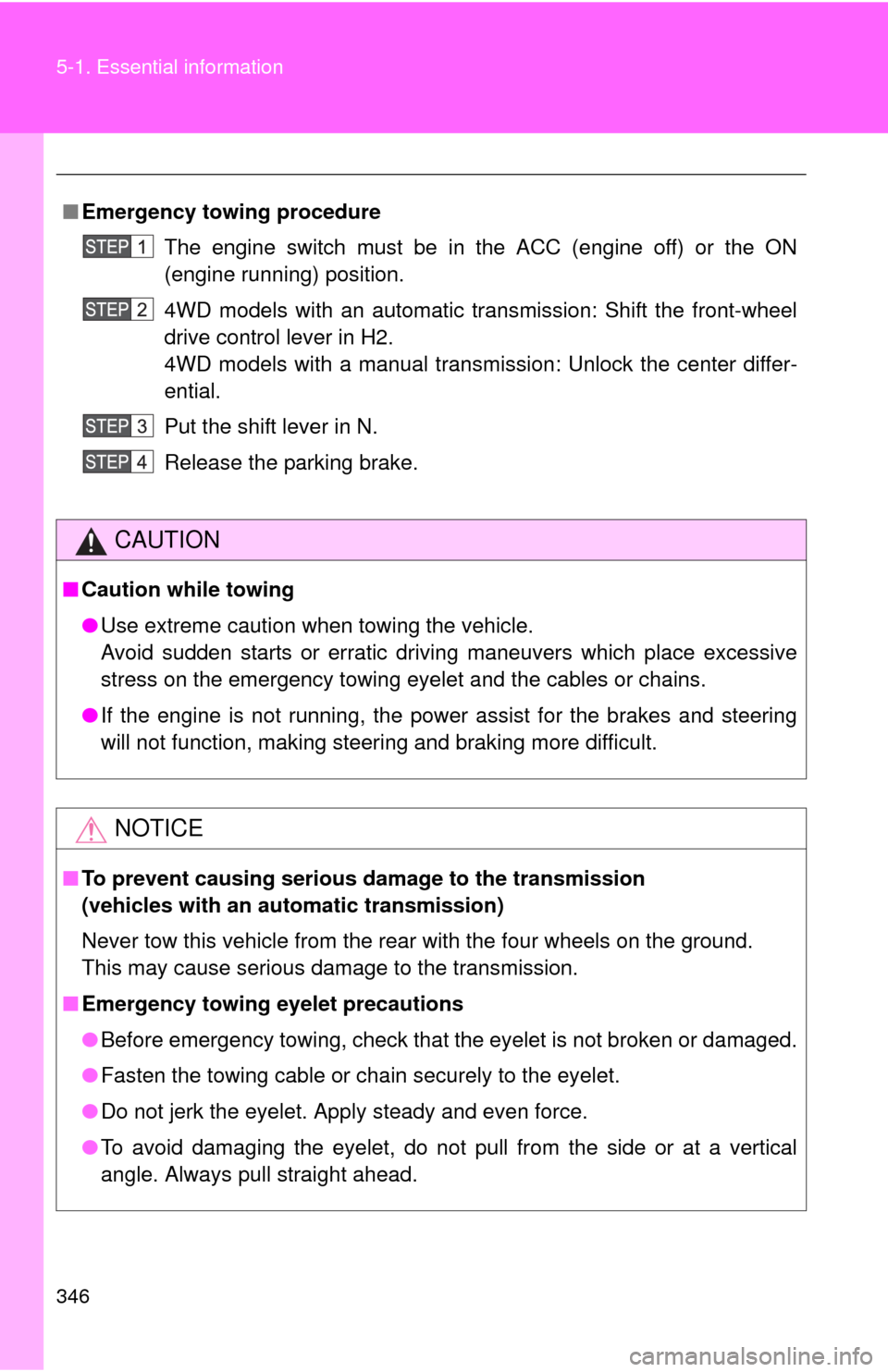
346 5-1. Essential information
■Emergency towing procedure
The engine switch must be in the ACC (engine off) or the ON
(engine running) position.
4WD models with an automatic transmission: Shift the front-wheel
drive control lever in H2.
4WD models with a manual transmission: Unlock the center differ-
ential.
Put the shift lever in N.
Release the parking brake.
CAUTION
■Caution while towing
●Use extreme caution when towing the vehicle.
Avoid sudden starts or erratic driving maneuvers which place excessive
stress on the emergency towing eyelet and the cables or chains.
●If the engine is not running, the power assist for the brakes and steering
will not function, making steering and braking more difficult.
NOTICE
■To prevent causing serious damage to the transmission
(vehicles with an automatic transmission)
Never tow this vehicle from the rear with the four wheels on the ground.
This may cause serious damage to the transmission.
■Emergency towing eyelet precautions
●Before emergency towing, check that the eyelet is not broken or damaged.
●Fasten the towing cable or chain securely to the eyelet.
●Do not jerk the eyelet. Apply steady and even force.
●To avoid damaging the eyelet, do not pull from the side or at a vertical
angle. Always pull straight ahead.
Page 348 of 439
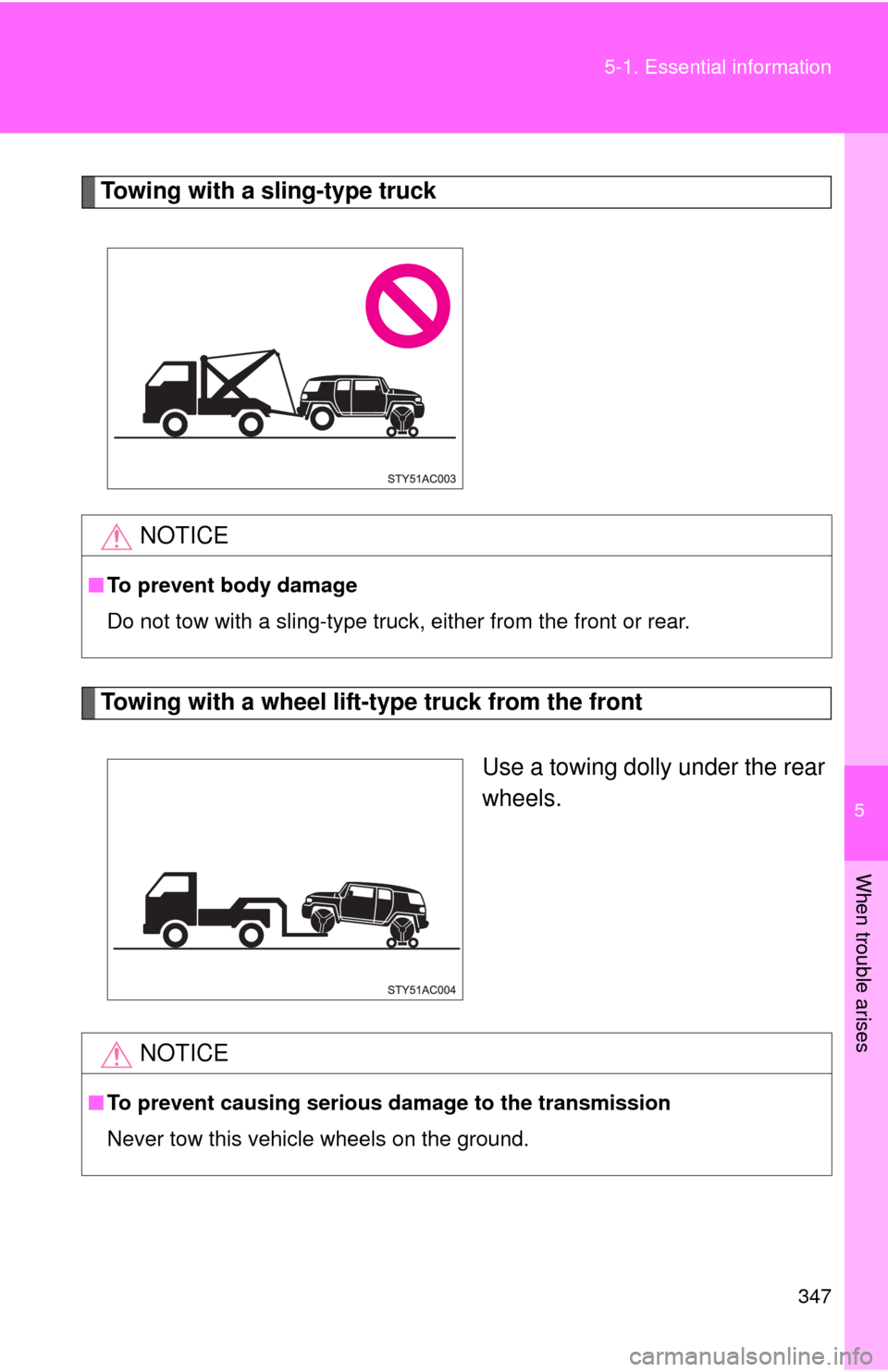
5
When trouble arises
347 5-1. Essential information
Towing with a sling-type truck
Towing with a wheel lift-type truck from the front
Use a towing dolly under the rear
wheels.
NOTICE
■To prevent body damage
Do not tow with a sling-type truck, either from the front or rear.
NOTICE
■To prevent causing serious damage to the transmission
Never tow this vehicle wheels on the ground.
Page 349 of 439
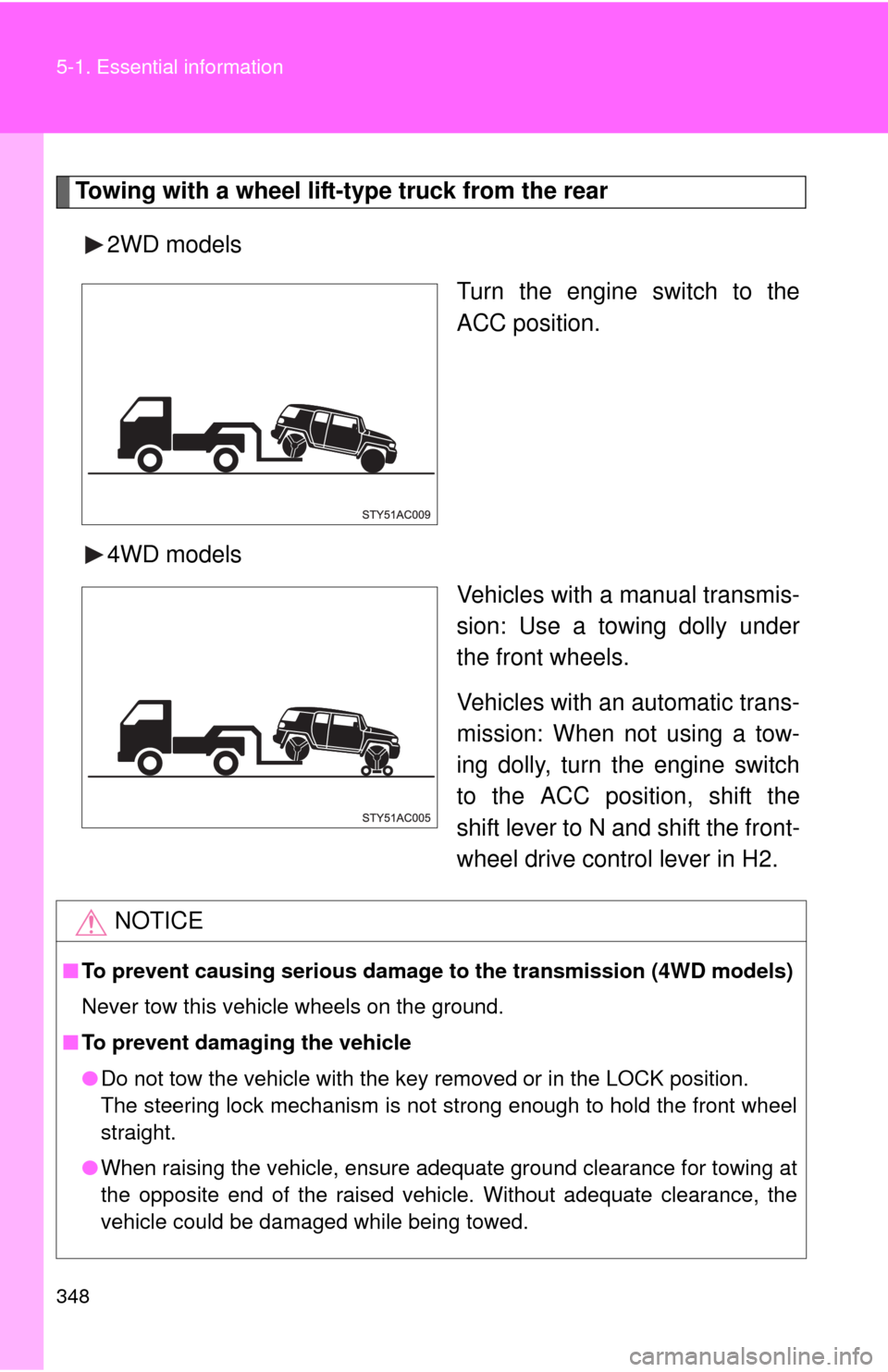
348 5-1. Essential information
Towing with a wheel lift-type truck from the rear
2WD models
Turn the engine switch to the
ACC position.
4WD models
Vehicles with a manual transmis-
sion: Use a towing dolly under
the front wheels.
Vehicles with an automatic trans-
mission: When not using a tow-
ing dolly, turn the engine switch
to the ACC position, shift the
shift lever to N and shift the front-
wheel drive control lever in H2.
NOTICE
■To prevent causing serious damage to the transmission (4WD models)
Never tow this vehicle wheels on the ground.
■To prevent damaging the vehicle
●Do not tow the vehicle with the key removed or in the LOCK position.
The steering lock mechanism is not strong enough to hold the front wheel
straight.
●When raising the vehicle, ensure adequate ground clearance for towing at
the opposite end of the raised vehicle. Without adequate clearance, the
vehicle could be damaged while being towed.
Page 350 of 439
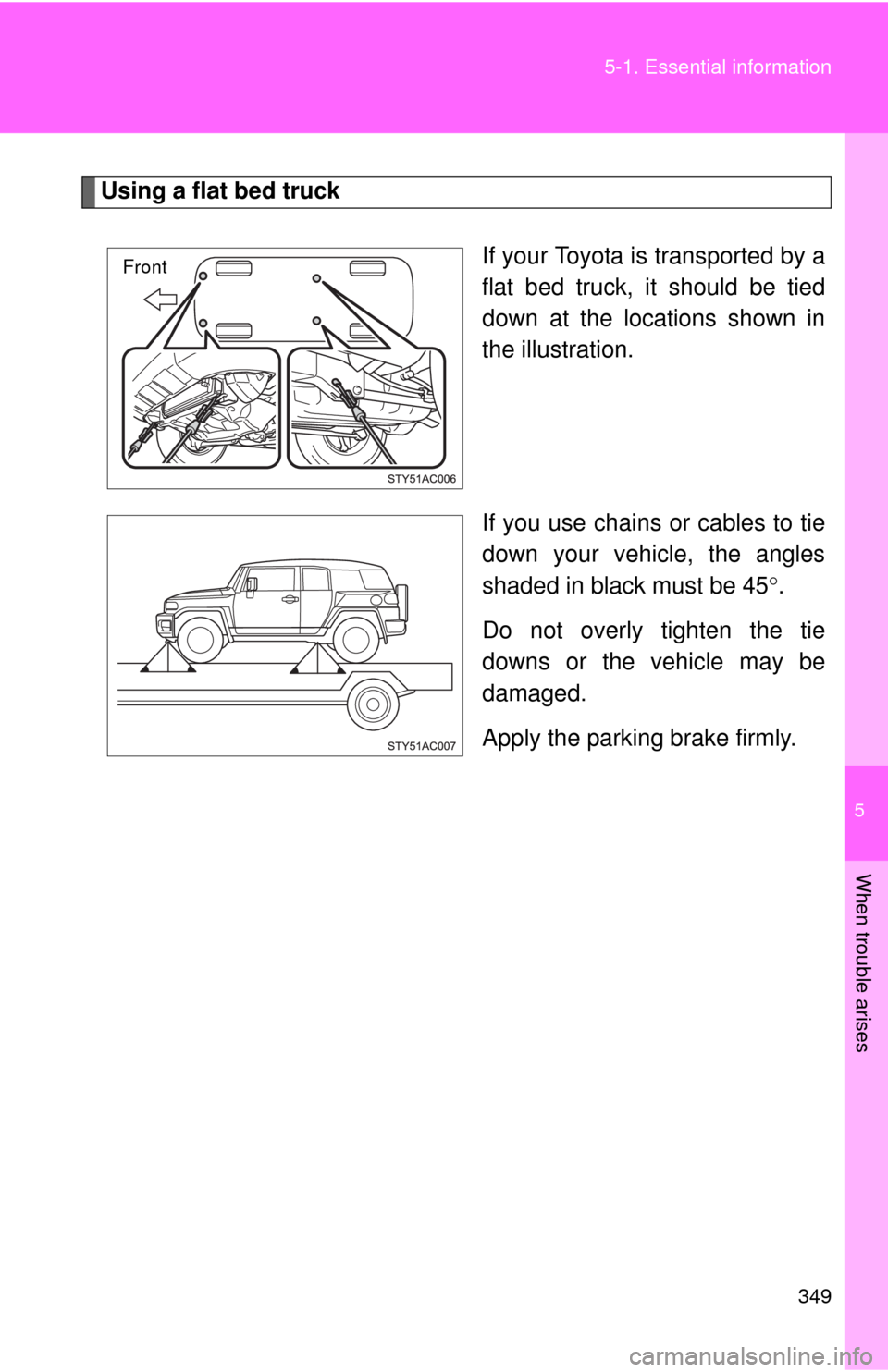
5
When trouble arises
349 5-1. Essential information
Using a flat bed truck
If your Toyota is transported by a
flat bed truck, it should be tied
down at the locations shown in
the illustration.
If you use chains or cables to tie
down your vehicle, the angles
shaded in black must be 45.
Do not overly tighten the tie
downs or the vehicle may be
damaged.
Apply the parking brake firmly.
Front